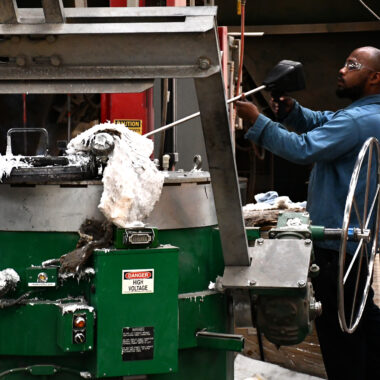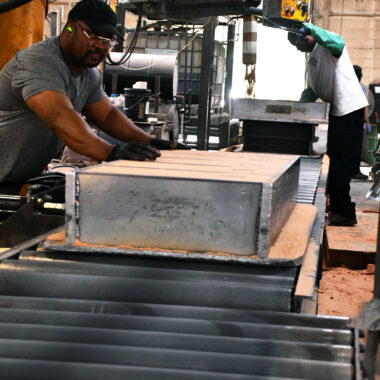Study the Globe of Aluminum Spreading: Understanding the Various Techniques
Aluminum casting is a fundamental procedure in the production sector, with different techniques employed to develop complex and exact parts. From the conventional sand casting technique to the innovative die casting procedure, each technique uses distinct benefits depending on the demands of the task.
Sand Spreading Technique
Sand spreading, a widely-used technique in light weight aluminum casting procedures, entails creating molds made of compressed sand for pouring liquified steel. When the mold and mildew is prepared, it is securely positioned in a flask and molten light weight aluminum is poured right into the tooth cavity.
After the steel has cooled and strengthened, the sand mold and mildew is escaped to reveal the light weight aluminum spreading. Sand spreading permits the manufacturing of intricate forms and huge parts that might be costly or challenging to generate using other approaches. It is additionally a lasting strategy as the sand can be reused and used numerous times, minimizing waste in the spreading procedure.
Permanent Mold Strategy

One substantial advantage of the Long-term Mold And Mildew Method is the enhanced dimensional precision it supplies. The metal mold and mildew enables tighter resistances and better details in the last aluminum castings compared to sand casting approaches. This accuracy makes it a favored choice for applications where tight dimensional control is vital, such as in the automotive and aerospace markets.

Die Casting Refine

Financial Investment Casting Technique
Making use of an accuracy spreading technique, Financial investment Casting Method includes producing intricate light weight aluminum components by pouring molten metal right into a ceramic mold. This procedure, additionally understood as lost-wax spreading, begins with the production of a wax pattern of the wanted part. This wax pattern is then covered with a ceramic product to develop a shell. Once the ceramic covering is solidified, it is warmed to get rid of the wax, leaving a hollow ceramic mold and mildew.
The next step includes putting the molten aluminum right into the ceramic mold and mildew. The aluminum loads the cavity left by the wax pattern, taking its form specifically. This approach is preferred for its ability to produce complicated forms with high accuracy and a smooth surface coating. Financial investment spreading is generally utilized for producing components in industries where tight resistances and detailed designs are called for, such as aerospace, auto, and clinical tools. The flexibility and precision of the Financial investment Casting Technique make it a useful strategy on the planet of aluminum casting.
Lost Foam Casting Technique
Having actually explored the complex accuracy of Investment Casting Technique, the focus currently shifts to the cutting-edge technique of Lost Foam Casting in light weight aluminum component manufacturing. Lost Foam Casting, additionally known as evaporative pattern spreading, is a modern-day strategy where a foam pattern of the wanted component is created and after that coated with a refractory product.
Among the primary advantages of Lost Foam Learn More Spreading is its capability to generate complex forms with intricate details, usually in a single item without the need for extra machining. This approach is also recognized for its high dimensional accuracy and smooth surface finish. In Addition, Lost Foam Spreading is an affordable process as it decreases the demand for cores and enables the production of lightweight parts. Despite its benefits, Lost Foam Spreading needs careful control of the spreading procedure to guarantee and prevent flaws quality parts.
Conclusion
In verdict, light weight aluminum spreading supplies a selection of approaches such as sand casting, permanent mold and mildew strategy, pass away spreading, investment spreading, and lost foam spreading. Each technique has its own advantages and applications, making light weight aluminum casting a flexible and extensively made use of process in various markets. Understanding the differences in between these methods is critical in picking the most ideal spreading technique for specific manufacturing requirements.
Sand casting, a widely-used method in aluminum spreading procedures, entails creating pop over to these guys molds made of compressed sand for pouring molten metal. aluminum casting.The Long-term Mold And Mildew Technique, like sand casting, is an additional widespread approach used in aluminum casting procedures, providing unique advantages in terms of mold and mildew reusability and dimensional accuracy. The metal mold and mildew permits for tighter resistances and better information in the final aluminum spreadings contrasted to sand casting methods. The two main types of die casting are chilly chamber die spreading and warm chamber die casting, each ideal for various types of aluminum alloys.In verdict, light weight aluminum spreading provides a variety of techniques such as sand casting, irreversible mold and mildew technique, die spreading, investment casting, and shed foam casting